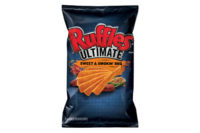![]()
Men
Sure men buy candy. And if marketers targeted them
better, they’d buy even more.
In consumables, what do men
typically crave? Steak, potato chips, beer—and yes, even candy. After
all, men were kids once, too, and they have fond memories of the sweet
stuff. Some have nostalgic favorites, others like to bite into something
rich and gooey, and many just have a sweet tooth. If only men were more
understood by candy marketers.
“The really cool segment to study right now is
men,” says Rob Frankel, a branding expert based in Los Angeles.
“It is one of the most underserved markets ever, but I think
we’ll see that turning around over the next decade.”
We’ve often heard that women outnumber men, and
indeed, the U.S. Census confirms that fact: there are 96 males for every
100 females in this country. The male population is expected to grow 9.7
percent by 2010.
But growth rates and ratios really have nothing to do
with why men are under-marketed in consumables such as candy. The real
reason is because women are the primary grocery shoppers—some 85
percent of food shopping is done by women, according to several shopping
studies.
Of course, times are changing now, and as many
Generation X men are becoming fathers, the country is seeing more men opt
to stay home with the kids. With this, comes the responsibility of grocery
shopping—Dad is often the new source for candy, and while he’s
at it, he may pick up some treats.
What’s particularly pertinent for candy
marketers is that men typically don’t associate weight gain with
candy the way women do, and if marketed to properly, the potential for
increased sales to men is enormous. n
Marketing to Men Don’ts
1. Don’t market candy to men’s emotions. They
will respond much better to the facts.
2. Don’t make men the butt of an advertising joke. "Generation X is particularly guilty of this type of advertising, and it’s not too bright," says Rodger Roeser, vice president of public relations for Justice & Young, a marketing firm based in Cincinnati. "We see a lot of bizarre hidden commercial messages that make fun of men and empower women."
2. Don’t make men the butt of an advertising joke. "Generation X is particularly guilty of this type of advertising, and it’s not too bright," says Rodger Roeser, vice president of public relations for Justice & Young, a marketing firm based in Cincinnati. "We see a lot of bizarre hidden commercial messages that make fun of men and empower women."
Merchandising Mandates
Typically men do not shop from a list, so they’re
more apt to make impulse purchases—candy!—for themselves and their
children. Are candy marketers taking advantage of this?
Men do not typically clip coupons or look for what’s on sale. Rather, they prefer to buy products they think are a good value for the money, often buying more higher-priced items than women do. Therefore, they are a natural target for more premium/gourmet candy.
Men like to be shown a product clearly and with as much information as possible. They are problem solvers and want the facts. Sometimes their problem is hunger; other times it’s the need for a gift. Candy marketers that speak to them clearly and intelligently will get their confectionery dollars.
Co-branding works well with the male species. That includes positioning candy with other products men buy, as well as using male-oriented sponsorships and co-branding promotions to get them to understand a candy marketer is talking to them.
Men do not typically clip coupons or look for what’s on sale. Rather, they prefer to buy products they think are a good value for the money, often buying more higher-priced items than women do. Therefore, they are a natural target for more premium/gourmet candy.
Men like to be shown a product clearly and with as much information as possible. They are problem solvers and want the facts. Sometimes their problem is hunger; other times it’s the need for a gift. Candy marketers that speak to them clearly and intelligently will get their confectionery dollars.
Co-branding works well with the male species. That includes positioning candy with other products men buy, as well as using male-oriented sponsorships and co-branding promotions to get them to understand a candy marketer is talking to them.



